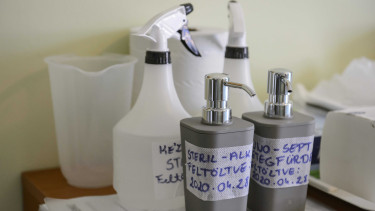Respiratory infections retreat in Hungary after three weeks of worsening statistics

The flu season generally peaks between the 7th and 10th week of the year, but the highest figures can vary greatly from one year to another. The coronavirus pandemic, for instance, put a serious dent into the spread of the flu due to mask-wearing and social distancing (see graph below).
The number of people seeking medical help with influenza-like symptoms per 100,000 population (67.2) was never higher than currently in the past 12 cold seasons, although last year came close (64.5).
For the 52nd week of 2023, the NNK published only a couple of figures, hence the gaps in the graphs.

On the 18th week of 2024, a total of 122,500 people sought medical help with acute respiratory infection (ARI), of whom 6,500 (5.3%) had flu-like symptoms. The former figure marks a 14.2% decrease after rising for three weeks, while the latter is 22.6% lower than a week earlier, after w/w decreases of between 6.1% and 9.3% on the preceding three weeks.
The rise in the number of ARI patients on the 15th week had to do with the fact that the 14th week had only four working days and during holidays people rather stay clear of the doctor unless it's an emergency. After essentially summer temperatures the weather turned chilly about a month ago and remained that way bar several days, hence the rise in ARI stats even on the 16th and 17th week.

We can also compare the ARI and flu numbers for 100,000 inhabitants. The epidemic has been more severe in this respect in 2023/24 than in 2022/23 in 42% of the weeks so far, between the 47th week of 2023 and the 7th week of 2024 and on the 17th week this year.

We need to note that this year authorities perform more tests than a year ago, even though the number of samples tested remains extremely low (76 in total on a national level last week, down from 112 on the 17th week).

As regards all samples tested up to the 18th week, the Covid positivity rate continues to be the highest, but the flu positivity rate is coming up and might eventually catch up (or not). It has time to do so until the 20th week when the NNGYK stops publishing epidemiological data for this flu season.

If we take a look at the positivity rates on the individual weeks, we find that there was a turnaround on the 2nd week, with the influenza positivity rate (14.0%) higher than the Covid positivity rate (13.6%) for the first time in the current flu season. The gap has widened considerably, reaching 38.8% percentage points on the 6th week and has since not only come down but also reversed to -1.3% on the 18th week.
The influenza positivity rate was higher a year ago (5.6% vs. 0.0%), and the Covid positivity rate is also lower currently (1.3% vs. 11.1% a year ago), while the RSV rate was lower a year ago at 0% versus 3.9% currently.

The share of coronavirus in all samples tested (orange lines) was a lot smaller a year ago (10.3%) than currently (15.3%), while the percentage of influenza in the samples (green lines) is considerably lower now (14.6%) than in the period between the 40th week of 2022 and the 18th week of 2023 (42.5%).
As regards the prevalence of respiratory syncytial virus (RSV) in the samples (blue lines), the situation is much better in the current cold season than in 2022/23, with the share only at 5.2% by the 18th week this year versus 9.7% a year ago. Note that these are the percentages of the select pathogens found in all samples tested up to the 18th week.

People tested positive for influenza and RSV had to be hospitalised for the 20th consecutive week in this flu season. The 47th week was the first one when one of the samples showed influenza infection (up at 1,025 in total by the end of the 17th week). Other pathogens identified between the 40th and 18th week were SARS-CoV-2 (1,072), respiratory syncytial virus (RSV, 362), adenovirus (9), parainfluenza (12), human metapneumovirus (HMPV, 175, and rhinovirus (63).
The graphs below show a comparison with the previous 'flu season'. In 2022/23, there were no reports of people with Covid in hospitals up to the end of 2022, but that doesn't mean there weren't any (there were 100 on the first week of 2023, so it's a pretty safe bet that not all of them got to that stage overnight). In this respect, the Covid situation is now a lot better.

The following chart depicts the number and share of people infected by influenza virus who had to be hospitalised. As you can see (orange columns, light blue curve), this 'flu season' was worse in this respect than the previous one up to the 8th week, but we see a turnaround on the 9th week and a sharp drop on the 10th week with a further decline on subsequent weeks. The share of influenza patients of all people in hospital (2 out of 65) is higher now (3.1%) than a year go (0.0%). (The chart starts on the 49th week because that was the first week in this season when someone infected with influenza virus had to be hospitalised.)

We have the same graph for respiratory syncytial virus (RSV), which shows that this infection was more severe in the previous 'flu season' up to the sixth week, but there was a turnaround on the 7th week. The number of people treated with RSV in hospitals dropped, and their share as a percentage of all people hospitalised with SARI rose to 4.6% on the 18th week, remaining higher than a year ago (3.7%) but only because there were only 65 people in hospital with SARI on the 18th week this year, against more than double (134) a year ago.

Another important indicator of the severity of an epidemic is how many of those hospitalised end up in the intensive care unit.
There were 65 people with SARI in hospital on the week under review, down from 78 a week earlier. Seven of them were in the ICU, unchanged from a week ago, which corresponds to a 10.8% ratio, up from 9.0%.

Fewer children get sick
Finally, we have an age breakdown both for ARI and flu patients. Children up to the age of 14 remain on top of the ARI age rankings in terms of numbers. After 11 consecutive months they were no longer on top in the flu rankings (29.3%) on the 15th week, as the hardest-hit cluster has become the 15-34 age group (32.3%), although the difference in numbers is negligible (about 300 people). The same went for the 16th week, with the difference shrinking further (2,907 vs. 3,082), and on the 17th week the youngest took the lead again, which remained so on the 18th week (2,093 vs. 2,080). The right-hand charts show the share of people with ARI and flu-like symptoms by age group.
On the 18th week this year, about 63,450 children sought medical help with ARI, a decrease of some 11.200 from a week ago, They represented 51.8% of all people that turned to the doctor with some respiratory infection.




Cover photo: Getty Images




